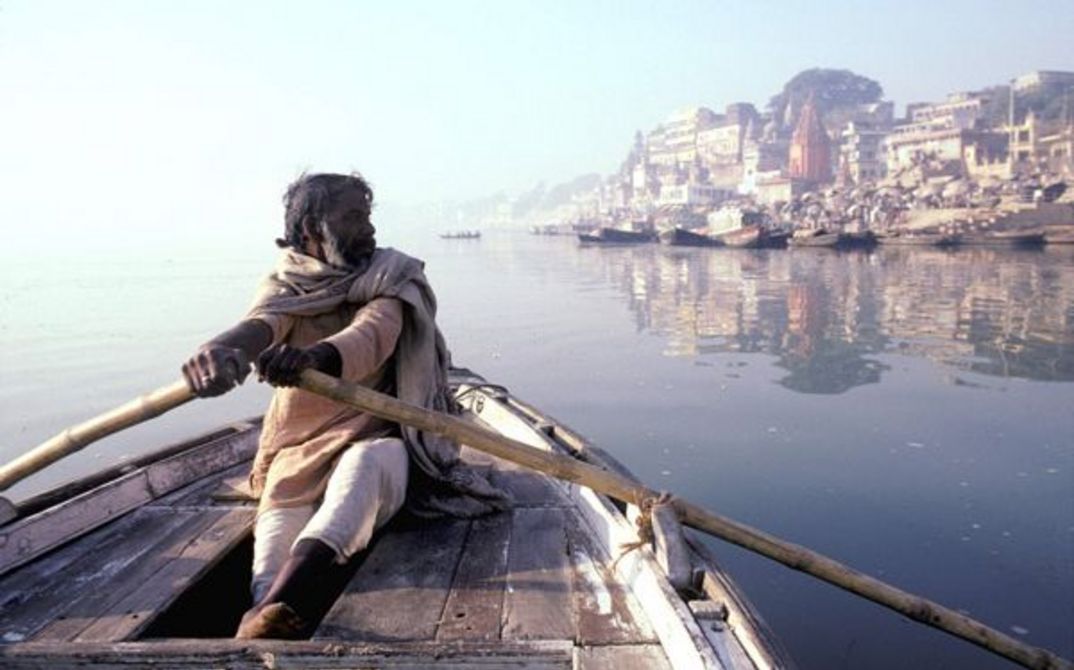FOREST OF BLISS (USA 1985, 21. 6., Introduction: Michael Baute & 25.6.) Robert Gardner's magnum opus takes us to the banks of the Ganges in the holy Indian city of Varanasi from dusk till dawn. It is a film essay about the cycle of life and death, past and renewal. Made in close cooperation with the ethnologist Áskos Östör, the film examines the ceremonies and rituals of death in the city, as well as the interconnected economic aspects. The symbolic visual world, with its recurring motifs of water and fire, marigolds and wood, bodies and cows, boats, staircases and kites create a relationship between the sacred and the profane. Without commentary or subtitled dialogues, this is an incredibly dense description of a world of images and sounds, into which the viewer is thrown without explanation.
DEAD BIRDS (USA 1963, 22. & 26.6.) In 1961, Robert Gardner led a large-scale expedition to the New Guinea Highlands to study and film the Dani people, with the support of the Peabody Museum of Archaeology and Ethnology at Harvard. Dani society is characterized by permanent ritualized war in which every death has to be avenged so that life regains its balance. Gardner concentrates on two protagonists - the warrior Weyak and the small boy Pua. The film features masterful montage and a lyrical commentary spoken by Gardner himself that is rich in metaphor and relates the thoughts and feelings of the protagonists, incorporating mythical elements. "It was an attempt to see people from within and to wonder, when the selected fragments of that life were assembled, if they might speak not only of the Dani but also of ourselves."(Robert Gardner)
RIVERS OF SAND (USA 1974, 23. & 27.6.) portrays the Hamar people in southwestern Ethiopia and explores male supremacy in the society, whose expression includes the ritual whipping of young women. The leitmotif of male superiority is also explicit in the direct speech of Omali Inda, a Hamar woman who uses language rich in innuendo to report on the individual and general experiences of women. "Hamar men are masters and their women are slaves. The film is an attempt to disclose not only the activities of the Hamar, but also the effect on mood and behavior, of a life governed by sexual inequality." (Robert Gardner) In this film - made and seen in the context of the women's movement in the West - Gardner also reflects upon his own role as a husband and father.
MARK TOBEY (USA 1952, 24. & 29.6.) Robert Gardner's second film was an experimental portrait about the abstract painter Mark Tobey, who lived in Seattle at the time of filming. Gardner observed him at work and in his daily life, while Tobey helped to shape the film itself. With its associative imagery, it was clearly influenced by US avant-garde films of the post-war ear. SONS OF SHIVA (Robert Gardner, Ákos Östör, USA 1985, 24. & 29.6.) is part of the "Pleasing God"-trilogy about Hindu rites in India that Ákos Östör made with Robert Gardner and Allen Moore.
SONS OF SHIVA was the only part that Gardner directed: It depicts the four-day Gajan festival to honor Shiva in Vishnupur, observing believers taking part in their individual practice or group rituals and the intensification of activities related to the worshipping of Shiva and contrasting these with profane acts. Recurring motifs and symbols of transcendence structure the film and compress the believers' reveries into an impressive audiovisual work of art.
CORRESPONDENCE (Robert Fenz, USA/G 2011, 24. & 29.6.) Through his work at the Harvard Film Study Center and the restoration of Gardner's films, the experimental filmmaker Robert Fenz was able gain a profound familiarity with the director's oeuvre. Decades later, he visits the settings of Gardner's three most important films for a 30 minute 16mm film: New Guinea, Ethiopia and India (Varanasi). Like Gardner, Fenz reflects on the ephemeral nature of human experience and is driven by the same question: How can the world be captured on film? An homage to Robert Gardner. (al)
